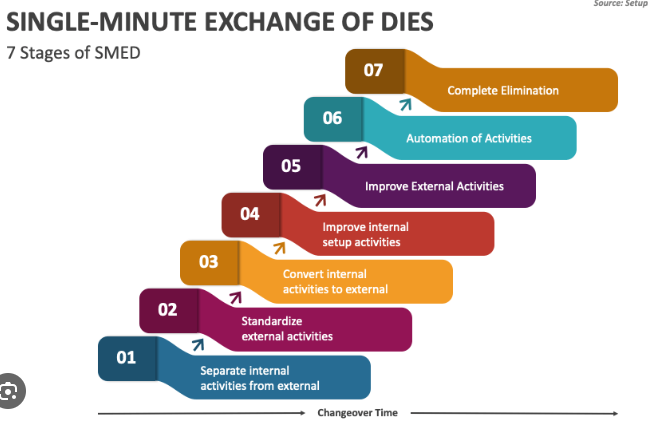SMED (Single-Minute Exchange of Die) is a lean manufacturing methodology aimed at reducing the setup or changeover time required for equipment or processes. The primary objective of SMED is to minimize non-value-added activities, such as downtime during changeovers, and to increase the efficiency and flexibility of manufacturing operations. Implementing SMED can bring several significant benefits to an organization:
- Reduced Setup Time: The most immediate benefit of SMED implementation is the reduction in setup time. By streamlining the setup process, organizations can significantly decrease the time it takes to switch between different products or tasks. This allows for more frequent changeovers, which can facilitate smaller batch sizes, improve responsiveness to customer demands, and increase overall production capacity.
- Increased Equipment Utilization: With shorter setup times, equipment downtime is minimized, leading to increased equipment utilization. This means that machinery spends more time in operation, producing goods rather than being idle during changeovers. Improved equipment utilization can lead to higher output levels without the need for additional investments in machinery.
- Reduced Inventory Levels: SMED enables organizations to adopt a just-in-time (JIT) manufacturing approach by reducing the need for large inventories of intermediate or finished goods. With quicker changeovers, companies can produce smaller batches more frequently, thereby reducing inventory holding costs, minimizing the risk of obsolescence, and freeing up valuable working capital.
- Flexibility and Responsiveness: Shorter setup times enhance a company’s ability to respond quickly to changes in customer demands, market conditions, or product specifications. By being able to switch production lines or processes more rapidly, organizations can adapt to changing requirements more effectively, seize new opportunities, and remain competitive in dynamic markets.
- Improved Quality: SMED implementation often involves standardizing setup procedures and implementing error-proofing mechanisms, such as checklists or visual controls. This standardized approach helps reduce the risk of errors or defects during changeovers, leading to improved product quality and customer satisfaction.
- Employee Empowerment and Engagement: Involving employees in SMED activities fosters a culture of continuous improvement and empowers frontline workers to identify and eliminate waste in their own work areas. This engagement can boost morale, encourage collaboration across teams, and drive innovation as employees seek out more efficient ways to perform their tasks.
- Cost Savings: By reducing setup times, improving efficiency, and optimizing resource utilization, SMED implementation can lead to significant cost savings for organizations. These savings may result from lower labor costs, reduced inventory carrying costs, decreased downtime, and improved overall productivity.
- Competitive Advantage: Ultimately, the successful implementation of SMED can provide organizations with a sustainable competitive advantage. By enhancing operational efficiency, flexibility, and responsiveness, companies can better meet customer needs, adapt to market changes, and outperform competitors in terms of cost, quality, and delivery speed.
In conclusion, the detailed value of SMED implementation extends beyond just reducing setup times; it encompasses a wide range of benefits, including improved efficiency, flexibility, quality, employee engagement, and cost savings, ultimately contributing to the overall success and competitiveness of an organization.
GKW Business Solutions offers a 5 Day SMED Workshop to teach your team how to take advantage of this Lean Tool. Contact Will or I for details.




